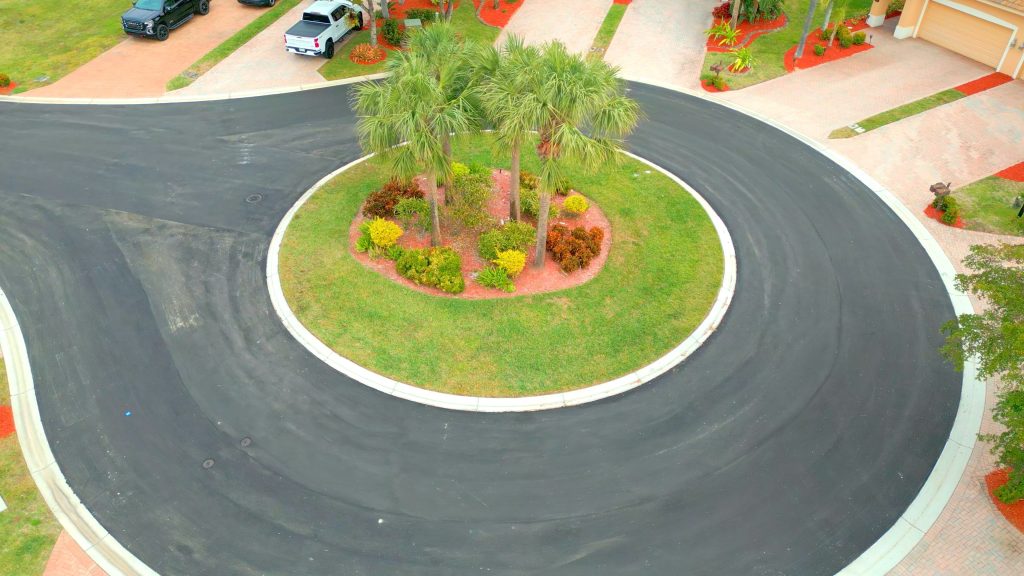Asphalt overlays are a cost-effective way to extend the life of your commercial parking lot or paved surface, without the expense of full reconstruction. But just like any paving service, the price tag for overlays can vary widely depending on a number of key factors.
Whether you’re budgeting for a capital improvement plan or comparing bids from contractors, this guide breaks down the main cost drivers behind commercial asphalt overlays in 2025.
Quick Definition: What Is an Asphalt Overlay?
An asphalt overlay is the process of applying a new layer of hot mix asphalt (typically 1.5–2 inches thick) over an existing pavement structure. It improves appearance, smoothness, and ride quality while sealing cracks and preventing further deterioration.
🔄 Overlays are only viable when the base structure is still sound. If the base is failing, a full-depth replacement may be needed.
Related: When to Choose an Asphalt Overlay vs. Full Repaving
1. Condition of the Existing Asphalt
This is the biggest cost factor. Overlays are only appropriate if the existing asphalt is structurally stable and doesn’t have widespread base damage.
If your surface has:
- Minor surface cracking
- Slight raveling or oxidation
- Light rutting
…you’re a great overlay candidate. But if there’s:
- Alligator cracking
- Severe potholing
- Base/sub-base movement
…you’re likely looking at mill and replace, or even full-depth reconstruction, both of which cost significantly more.
Related: Signs Your Commercial Asphalt Needs Resurfacing or Replacement
2. Overlay Thickness
The thicker the overlay, the more material and labor are required, driving up cost. Most commercial overlays range from 1.5 to 3 inches.
| Overlay Thickness | Typical Use Case | Cost Impact |
|---|---|---|
| 1.5 inches | Light-duty traffic areas | Lower cost |
| 2–3 inches | Heavy traffic/trucks | Higher cost |
Also, thicker overlays may require milling at transitions (curbs, drains, ADA ramps) to avoid creating height issues or water pooling.
3. Milling Requirements
If your overlay includes milling (grinding down the existing surface), that adds time and cost to the project. Milling is often required to:
- Maintain proper elevations
- Avoid drainage issues
- Tie into existing features like sidewalks or concrete aprons
⚙️ Milling costs range from $0.30 to $0.60 per sq ft, depending on depth and complexity.
4. Size and Layout of the Project
As with any paving work, larger projects benefit from lower per-square-foot pricing.
Open rectangular lots = faster production
Tight layouts, curbing, or obstacles = slower, more labor-intensive = higher cost
Rule of thumb: Overlay projects over 50,000 sq ft usually fall into the $2.50–$4.00/sq ft range in most U.S. markets.
5. Type of Asphalt Mix Used
Not all hot mix asphalt (HMA) is created equal. Some overlays require:
- Polymer-modified mixes for higher durability
- Fine-graded mixes for smoother finishes
- Cold-weather formulations for off-season paving
Specialty mixes increase your material costs but offer better performance and lifespan.
6. Traffic Load Requirements
If your lot supports heavy commercial vehicles or delivery trucks, your overlay may require a stronger mix or additional thickness, especially in high-traffic areas like:
- Loading docks
- Drive lanes
- Dumpster pads
This increases both material and compaction time.
7. Geographic Location and Seasonality
Labor rates, material supply, and even fuel costs vary by region, and that directly affects paving costs.
- Urban areas (e.g., NYC, Chicago, LA): Higher labor + mobilization costs
- Rural or suburban zones: Lower average cost per foot
Also, paving in colder months or during off-season windows may require additives or premium mixes, raising the cost.
8. Required Surface Preparation
Surface prep is critical for overlay success. This may include:
- Cleaning and crack sealing
- Leveling low spots
- Tack coat application for bonding
- Patching deteriorated areas
Each adds marginal cost, but skipping them leads to failure.
Related: The Best Ways to Repair Cracks & Potholes in Asphalt
9. Add-Ons and Enhancements
Beyond the overlay itself, these additional items can impact the total price:
- Striping & signage: $0.15–$0.50/sq ft
- ADA compliance upgrades
- Drainage repairs or improvements
- Geotextile fabric for reinforcement: +$0.30–$0.60/sq ft
These may be required for compliance or durability, but should be included in your proposal upfront.
Asphalt overlays can save tens of thousands compared to full repaving—but only if the existing pavement structure qualifies.
To control overlay costs:
- Get a professional evaluation of your surface
- Choose a contractor experienced in commercial overlays
- Don’t cut corners on prep—cheap overlays fail fast
- Plan routine maintenance post-overlay
Related: How Often Should You Sealcoat Your Commercial Asphalt?
Also see: How Much Does Commercial Asphalt Paving Cost?
Get a custom overlay quote today. The Pavement Group specializes in commercial asphalt overlays for shopping centers, industrial facilities, schools, and corporate campuses nationwide.
Contact us to schedule a free site inspection.


